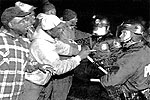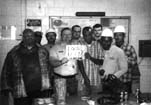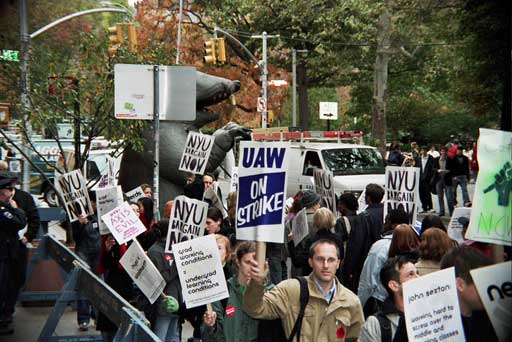Power of Labor

Charleston
Five longshoremen arrested for defending picket lines against cop
attack
(January 2000).
click
on photo for article

South
Carolina clay miners appeal for solidarity in fight for their union
(October
2001).
click
on photo for article

November 2005

New York University graduate students strike against union-busting NYU administration.
(Photo: GSOC/UAW)
“On
strike, shut it down, New York is a union town,” chant enthusiastic
pickets
in front of New York University in downtown Manhattan. NYU is the
largest
private university in the United States. Since November 9, graduate
students
there – who do much of the teaching and grading – have been on strike
for basic
union rights. The strike lines have repeatedly brought out hundreds of
picketers.
They’re
joined on the lines by members of many other unions, including
professors and
adjuncts from the City University of New York. CUNY is the country’s
largest
urban public university, and its teaching staff has been working
without a
contract for three years. On September 29, some 1,200 members of the
CUNY
faculty union jammed the Great Hall of Cooper Union for a meeting,
where every
reference to a possible strike was applauded. A strike at CUNY would
face the
Taylor Law banning public employee strikes in the state of New York.
A joint
strike by NYU and CUNY, a strike to win, that brings in
thousands of
undergrads and mobilizes real workers power to shut down the
campuses –
that’s what we need to be organizing to defeat the arrogant
administrations at both universities and win a real victory for us all.
This is
particularly important given the concerted assault against graduate
student
labor organizations across the country.
The
spirit is certainly there among NYU strikers, who display enormous
energy,
determination and creativity on the picket lines. Stickers proclaim
“Honor the
Picket Line,” “NYU on Strike” and the popular favorite: “The Nerds Are
Pissed.”
(A variant reads, “Nerds On Strike to Make You Even Smarter.”)
Hand-made signs
cover the gamut from “This Medievalist Won’t Be a Serf in [NYU
president John]
Sexton’s Fiefdom” to “WASPy Babes for GSOC.” The Graduate Student
Organizing
Committee is part of United Auto Workers Local 2210.
A
genuine campus spy story erupted in the strike’s second week. Outraged
faculty
members discovered that administrators had secretly joined “Blackboard”
electronic discussion groups in order to monitor pro-union opinions.
Professors
angrily protested that this action
“threatens academic freedom and autonomy.” Meanwhile, the
administration
set up a “snitch line” – a special phone number for those who want to
rat out
their TAs for going on strike.
Social
science students can see the class dynamics of the city minute by
minute, as
truckers, delivery van drivers, phone workers and cabbies honk in
support of
the strikers, while yuppie business types turn up their noses and hurry
past.
Class
is what it’s all about in a strike against NYU, a super-wealthy
institution
that’s one of the biggest landlords in the city. Rolling in money and
stoked on
a permanent power trip, the NYU administration thinks it can get away
with
blatant union-busting.
GSOC
was originally recognized following a 2000 National Labor Relations
Board
decision recognizing NYU graduate students’ right to a union contract.
But
following a new NLRB decision in 2004, NYU issued a diktat that
it would
no longer negotiate with the union, and slashed grad students’ health
care.
Labor leaders note Bush stacked the NLRB (the government body whose raison
d’être has always been to control and discipline labor). But,
as an article
in the Village Voice (16 November) noted, two top aides in
Sexton’s
union-busting crusade “emerged not from the GOP...but from the Clinton
White
House”: NYU’s VP for operations Jacob Lew, Clinton’s former Management
and
Budget head, and Cheryl Mills, one of Clinton’s lawyers during the
impeachment
flap. Yes, Virginia, the party of capital really is a bipartisan affair.
Reveling
in his tough-guy stance, Sexton proclaimed that the union can “either
die a
quick death or a slow death,” but the university won’t budge. As in any
strike,
what counts here is power. Grad students do not have the kind
of social
power that transport workers or coal miners do. They are a vulnerable,
usually
transient workforce. The key to winning a campus strike lies in
actually
shutting the campus down.
A
lively GSOC flyer, “Picketing 101,” reads “No scabbing! Don’t
teach,
research, or cross a picket line!” on one side and “Thank you for not
crossing
picket lines!” on the other. The chant “Picket lines mean don’t
cross”
was picked up with gusto when introduced by some CUNY Internationalist
Club
comrades. But it’s not enough to move classes off campus, as GSOC has
requested
and many sympathetic professors have done. In order to win this strike
it is
necessary to shut down classes, and to bring out
the rest
of NYU workers so that the university literally stops
functioning.
On
November 16, a group called Faculty Democracy called a “Town Hall
Meeting on
the Current Crisis on Campus,” inside NYU’s Silver Building. Many GSOC
members
asked whether they were supposed to go in, since it is a struck
building. To
their credit, GSOC picket captains built a large picket line around the
building, and most told strikers not to go in.
Yet
“The World Can’t Wait” (the latest liberal front group of the Maoist
RCP)
announced a “Drive Out the Bush Regime” meeting in a struck building.
On
November 19 a “Student Solidarity Meeting” was scheduled for another
part of
the struck campus. The Campus Antiwar Network, meanwhile, scheduled a
meeting
for November 29 in the struck Kimmel Building. Sending the message that
it is
OK to cross picket lines after all undercuts the most basic
understanding of
what the strike is all about. Picket lines mean don’t cross, period.
And the
key is to build militant picket lines that no one dares cross.
The
potential to win is shown by the willingness of many unionized truck
drivers to
stop deliveries rather than cross the picket lines. New York is a
union
town, and labor could mobilize thousands to shut the campus down in an
instant.
Yet the labor tops have limited themselves to the ritual arrest of
AFL-CIO head
John Sweeney at a September support rally.
NYU
employees are divided into various separate unions whose leaders
negotiate
separate expiration dates and have kept operations going during this
strike.
Maintenance, supply, elevator repair, garbage disposal and all the
other plant
work goes on. AFT Local 3882, representing clerical workers, just
signed a
contract, with a clause against sympathy strikes. Most absurd and
self-defeating is the existence of a separate union for NYU
adjuncts,
UAW Local 7902, which operates out of the same office as striking UAW
2110 –
but continues to work during the strike!
During
the 2003 Yale University strike, clerical and other workers mobilized
en masse,
shut down streets, paralyzed crucial work, and beat back a haughty,
aggressive
administration. Members of the Yale workers’ union have repeatedly come
to the
NYU picket lines to show their support. In contrast, the recent (2004
and 2005)
Columbia University graduate assistant strikes were lost: UAW 2110
struck but
the union tops had clerical and other workers, often members of the
same union,
continue to work.
The
concept of dividing the workforce into separate unions (craft unionism)
was
overcome in auto, steel, transport and other strategic industries in
the 1930s’
battles to build “industrial unions.” On college campuses seven decades
later,
splitting workers up this way just plays into the administration’s
divide-and-conquer strategy.
Fighting
to win the current NYU strike would help open the way to unite everyone
into a
single union of all university employees. This should include
the
professors, who don’t have their own NYU union and in most cases
continue to
teach; it clearly must not include administrators, campus cops and
other
enforcers for the employer.
The
CUNY administration matches NYU’s when it comes to high-handedness,
arrogance
and contempt for those who do the work on campus. It has pushed a hard,
anti-union, takeaway line in negotiations with the Professional Staff
Congress,
the faculty union whose contract expired back in ’02. Four
years have
gone by with no raise; the administration is bleeding the health-care
Welfare
Fund, and seeks a series of anti-union concessions. The CUNY teaching
staff has
been pushed beyond endurance.
Conditions
are particularly dire for CUNY’s adjuncts, who do most of the teaching
at City
University but are paid starvation wages (amounting to about $10 per
student
per month), with no job security, benefits or, in many cases, health
insurance.
At
the September 29 mass meeting at Cooper Union, PSC members heard the
union
leadership pledge not to negotiate a giveback contract. “Solidarity”
was
pledged by NYC school teachers’ union head Randi Weingarten – who just
shoved a
giveback contract down her members’ throats. Every mention of a
possible job
action was greeted by the standing-room-only crowd. When a CUNY adjunct
and
supporter of the Internationalist Group called to prepare for a strike
and to
smash the Taylor Law, he was enthusiastically applauded.
For
their part, CUNY’s chancellor and trustees have vowed to play hardball,
sending
an e-mail to every member of the teaching staff, threatening to use New
York
State’s Taylor Law – which makes it a crime for public employees to
“cause,
instigate, encourage or condone a strike.”
The
Taylor Law was passed one year after the 1966 subway strike, when TWU
leader
Mike Quill became an instant folk hero. Jailed for defying the
no-strike
Condon-Wadlin Act, he said, “The judge can drop dead in his black
robes. I
don’t care if I rot in jail – I won’t call off the strike!” The
strikers stuck
it out and won. A TWU official spoke at the September 29 PSC rally, yet
the
transport workers’ leadership, in thrall to the bosses’ politicians,
refuses to
use the power of this strategic union, which could shut the city down
and
spearhead a fight to smash the Taylor Law once and for all.
In
her speech to the rally, PSC President Barbara Bowen noted that the
administration’s intransigence is part of a “well-developed agenda of
dismantling the public sphere,” that CUNY “cuts costs in the
time-honored
corporate way” by replacing full-time faculty with underpaid
part-timers, and
“the austerity agenda for CUNY is an expression of contempt for our
students.” Particularly after all the
PSC leaders’ talk of a “job action” and criticisms of other city
unions’
giveback contracts, any concessions to CUNY’s takeback agenda would
greatly
undercut the union. Already, many counselors (who are heavily black and
Latino)
are up in arms, and rightly so, because the PSC tops have agreed to let
college
presidents reclassify them as HEOs (Higher Education Officers), meaning
they
would no longer be faculty and would be denied the right to vote on
many
matters. Many adjuncts, in turn, feel they are poorly
represented by the
union.
The
PSC leaders said that if a “realistic framework” for a settlement was
not
reached by November 3, they would decide whether to hold a “referendum
seeking
membership support for a job action.” Efforts to mobilize members were
stepped
up to some degree, but the deadline came and went, while no serious
push to win
crucial student support has been made. Most fundamentally, the PSC
leadership –
while priding itself on its “progressive” credentials in contrast to
the
previous, blatantly reactionary leaders – operates within the framework
of
Democratic Party-chained “labor statesmanship.”
Facing
a hard-line employer brandishing strike-breaking laws, an effective
fight
requires class-struggle methods and leadership. With NYU already on
strike, a
joint CUNY/NYU strike is clearly called for. For starters, strike
committees
should be elected now, at every CUNY campus. These committees should
bring
together PSC members, other campus workers and large numbers of
students,
mobilizing to shut the entire CUNY system down tight and bring in the
power of
the heavy battalions of NYC labor. A real fight for the right to
education
would get an enormous response from the multiracial, largely immigrant
working
class of this city.
Against
the haughty diktats of the CUNY and NYU tops, we call for abolition of
the
administration, for student-teacher-worker control of higher education,
and for
open admissions, no tuition and a living stipend for students, to make
education available to all. A struggle of this breadth and scope could
simultaneously turn back the wave of attacks on the right to campus
protest (as
in the Miguel Malo and Carol Lang cases at CUNY), and drive out the
recruiters
for the U.S. war machine. These points must be part of a program for
class-struggle leadership committed to breaking labor from the pro-war,
pro-Taylor Law Democratic Party and building a revolutionary workers
party.
As
“Picketing 101” implies, a strike can be a powerful learning
experience.
Striking NYU students have gotten a taste of the class struggle. As the
battle
goes on, those who want to win it will begin to draw some broader
conclusions.
They should give us a call. We’re the Internationalist Group and CUNY
Internationalist Clubs, and you can reach us at: internationalistgroup@msn.com
. n
To contact the League for the Fourth International or its sections, send an e-mail to: internationalistgroup@msn.com